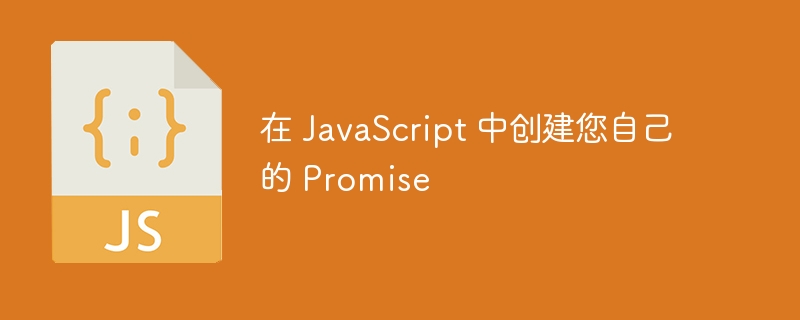在 JavaScript 中创建您自己的 Promise
时间:2024-12-31 12:22:10 246浏览 收藏
积累知识,胜过积蓄金银!毕竟在文章开发的过程中,会遇到各种各样的问题,往往都是一些细节知识点还没有掌握好而导致的,因此基础知识点的积累是很重要的。下面本文《在 JavaScript 中创建您自己的 Promise》,就带大家讲解一下知识点,若是你对本文感兴趣,或者是想搞懂其中某个知识点,就请你继续往下看吧~

深入JavaScript Promise:异步回调机制详解及自定义Promise实现
本文将带您深入了解JavaScript Promise的异步回调机制,并指导您亲自动手创建一个符合Promise/A+规范的Promise类。我们将重点关注Promise/A+规范中关键的规则,构建一个简化但功能完备的Promise实现。
一、核心概念
-
Promise: 一个带有
then方法的对象或函数,其行为符合Promise/A+规范。 -
Thenable: 定义了
then方法的对象或函数。 -
Value: 任何有效的JavaScript值(包括
undefined、Thenable或Promise)。 -
异常 (Exception): 使用
throw语句抛出的值。 -
Reason: 表示Promise被拒绝的原因的值。
二、Promise/A+规范关键规则解读与实现
2.1 Promise状态: Promise必须处于以下三种状态之一:待处理(pending)、已完成(fulfilled)或已拒绝(rejected)。
- 待处理: 可能转换为已完成或已拒绝状态。
- 已完成: 不得转换到任何其他状态,且必须有一个值,该值不得更改。
- 已拒绝: 不得转换到任何其他状态,且必须有一个原因,该原因不得更改。
实现:通过state属性跟踪Promise的状态,并使用value和reason属性存储相应的值和原因。状态转换仅在pending状态下进行。
const promise = new YourPromise((resolve, reject) => {
setTimeout(() => resolve('success!'), 1000);
});
promise
.then(value => {
console.log('fulfilled with:', value);
return 'next step';
})
.then(value => {
console.log('chained with:', value);
});
const promise2 = new YourPromise(resolve => resolve('immediately resolved!'));
console.log('before then()');
promise2.then(value => console.log('inside then():', value));
console.log('after then()');
四、总结
本文提供了一个简化版的Promise实现,帮助您理解Promise/A+规范的核心概念和实现细节。 完整的Promise实现更为复杂,需要处理更多边缘情况和规范细节,例如Promise的链式调用、then方法返回Promise的处理等。 但这个简化版本足以帮助您掌握Promise的本质。 希望本文能够帮助您更好地理解和运用JavaScript Promise。
终于介绍完啦!小伙伴们,这篇关于《在 JavaScript 中创建您自己的 Promise》的介绍应该让你收获多多了吧!欢迎大家收藏或分享给更多需要学习的朋友吧~golang学习网公众号也会发布文章相关知识,快来关注吧!
-
502 收藏
-
501 收藏
-
501 收藏
-
501 收藏
-
501 收藏
-
369 收藏
-
219 收藏
-
173 收藏
-
499 收藏
-
465 收藏
-
377 收藏
-
407 收藏
-
431 收藏
-
465 收藏
-
239 收藏
-
491 收藏
-
408 收藏
-

- 前端进阶之JavaScript设计模式
- 设计模式是开发人员在软件开发过程中面临一般问题时的解决方案,代表了最佳的实践。本课程的主打内容包括JS常见设计模式以及具体应用场景,打造一站式知识长龙服务,适合有JS基础的同学学习。
- 立即学习 543次学习
-

- GO语言核心编程课程
- 本课程采用真实案例,全面具体可落地,从理论到实践,一步一步将GO核心编程技术、编程思想、底层实现融会贯通,使学习者贴近时代脉搏,做IT互联网时代的弄潮儿。
- 立即学习 516次学习
-

- 简单聊聊mysql8与网络通信
- 如有问题加微信:Le-studyg;在课程中,我们将首先介绍MySQL8的新特性,包括性能优化、安全增强、新数据类型等,帮助学生快速熟悉MySQL8的最新功能。接着,我们将深入解析MySQL的网络通信机制,包括协议、连接管理、数据传输等,让
- 立即学习 500次学习
-

- JavaScript正则表达式基础与实战
- 在任何一门编程语言中,正则表达式,都是一项重要的知识,它提供了高效的字符串匹配与捕获机制,可以极大的简化程序设计。
- 立即学习 487次学习
-

- 从零制作响应式网站—Grid布局
- 本系列教程将展示从零制作一个假想的网络科技公司官网,分为导航,轮播,关于我们,成功案例,服务流程,团队介绍,数据部分,公司动态,底部信息等内容区块。网站整体采用CSSGrid布局,支持响应式,有流畅过渡和展现动画。
- 立即学习 485次学习
